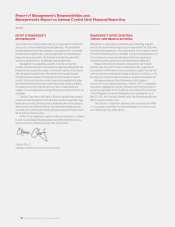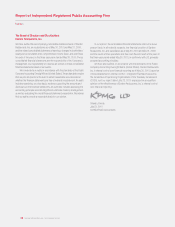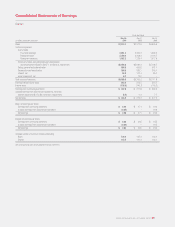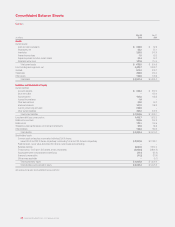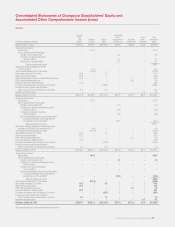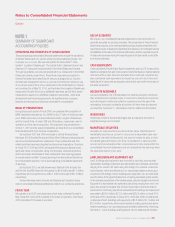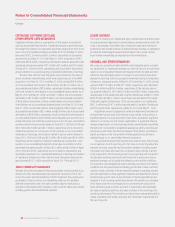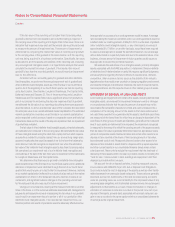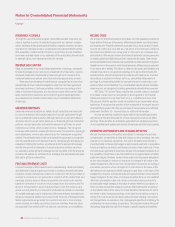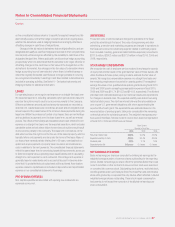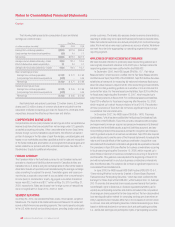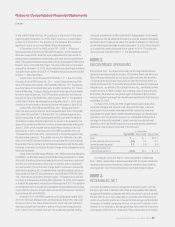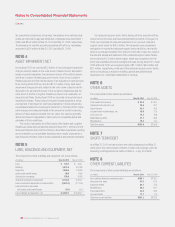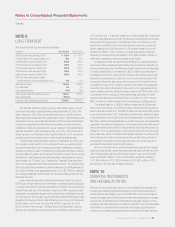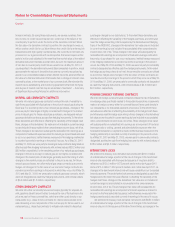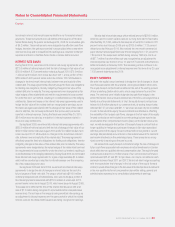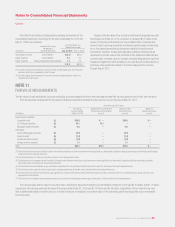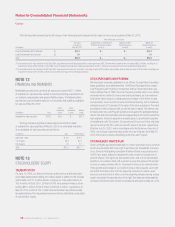Red Lobster 2010 Annual Report Download - page 48
Download and view the complete annual report
Please find page 48 of the 2010 Red Lobster annual report below. You can navigate through the pages in the report by either clicking on the pages listed below, or by using the keyword search tool below to find specific information within the annual report.
INSURANCE ACCRUALS
Through the use of insurance program deductibles and self-insurance, we
retain a significant portion of expected losses under our workers’ compen-
sation, employee medical and general liability programs. However, we carry
insurance for individual workers’ compensation and general liability claims
that exceed $0.5 million and $0.25 million, respectively. Accrued liabilities
have been recorded based on our estimates of the anticipated ultimate costs
to settle all claims, both reported and not yet reported.
REVENUE RECOGNITION
Sales, as presented in our consolidated statements of earnings, represents
food and beverage product sold and is presented net of discounts, coupons,
employee meals and complimentary meals and gift cards. Revenue from
restaurant sales is recognized when food and beverage products are sold.
Revenues from the sales of franchises are recognized as income when
substantially all of our material obligations under the franchise agreement
have been performed. Continuing royalties, which are a percentage of net
sales of franchised restaurants, are accrued as income when earned. Sales
taxes collected from customers and remitted to governmental authorities
are presented on a net basis within sales on our consolidated statements
of earnings.
UNEARNED REVENUES
Unearned revenues represent our liability for gift cards that have been sold
but not yet redeemed. We recognize sales from our gift cards when the gift
card is redeemed by the customer. Although there are no expiration dates or
dormancy fees for our gift cards, based on our historical gift card redemption
patterns, we can reasonably estimate the amount of gift cards for which
redemption is remote, which is referred to as “breakage.” We recognize
breakage within sales for unused gift card amounts in proportion to actual gift
card redemptions, which is also referred to as the “redemption recognition”
method. The estimated value of gift cards expected to go unused is recognized
over the expected period of redemption as the remaining gift card values are
redeemed. Utilizing this method, we estimate both the amount of breakage
and the time period of redemption. If actual redemption patterns vary from
our estimates, actual gift card breakage income may differ from the amounts
recorded. We update our estimate of our breakage rate periodically and apply
that rate to gift card redemptions.
FOOD AND BEVERAGE COSTS
Food and beverage costs include inventory, warehousing, related purchasing
and distribution costs and gains and losses on certain commodity derivative
contracts. Vendor allowances received in connection with the purchase of
a vendor’s products are recognized as a reduction of the related food and
bev erage costs as earned. Advance payments are made by the vendors
based on estimates of volume to be purchased from the vendors and the
terms of the agreement. As we make purchases from the vendors each
period, we rec ognize the pro rata portion of allowances earned as a reduction
of food and beverage costs for that period. Differences between estimated and
actual purchases are settled in accordance with the terms of the agreements.
Vendor agreements are generally for a period of one year or more and pay-
ments received are initially recorded as long-term liabilities. Amounts which
are expected to be earned within one year are recorded as current liabilities.
INCOME TAXES
We provide for federal and state income taxes currently payable as well as for
those deferred because of temporary differences between reporting income
and expenses for financial statement purposes versus tax purposes. Federal
income tax credits are recorded as a reduction of income taxes. Deferred
tax assets and liabilities are recognized for the future tax consequences
attributable to differences between the financial statement carrying amounts
of existing assets and liabilities and their respective tax bases. Deferred tax
assets and liabilities are measured using enacted tax rates expected to apply to
taxable income in the years in which those temporary differences are expected
to be recovered or settled. The effect on deferred tax assets and liabilities of a
change in tax rates is recognized in earnings in the period that includes the
enactment date. Interest recognized in accordance with reserves for uncertain
tax positions is included in interest, net in our consolidated statements of
earnings. A corresponding liability for accrued interest is included as a com-
ponent of other current liabilities in our consolidated balance sheets. Penalties,
when incurred, are recognized in selling, general and administrative expenses.
ASC Topic 740, Income Taxes, requires that a position taken or expected
to be taken in a tax return be recognized (or derecognized) in the financial
statements when it is more likely than not (i.e., a likelihood of more than
fifty percent) that the position would be sustained upon examination by tax
authorities. A recognized tax position is then measured at the largest amount
of benefit that is greater than fifty percent likely of being realized upon ultimate
settlement.SeeNote16–IncomeTaxesforadditionalinformation.
Income tax benefits credited to equity relate to tax benefits associated
with amounts that are deductible for income tax purposes but do not affect
earnings. These benefits are principally generated from employee exercises
of non-qualified stock options and vesting of employee restricted stock awards.
DERIVATIVE INSTRUMENTS AND HEDGING ACTIVITIES
We use financial and commodities derivatives to manage interest rate,
compensation, commodities pricing and foreign currency exchange rate risks
inherent in our business operations. Our use of derivative instruments is
currentlylimitedtointerestratehedges;equityforwardscontracts;commodities
futuresandoptionscontracts;andforeigncurrencyforwardcontracts.These
instruments are generally structured as hedges of forecasted transactions of
the variability of cash flows to be paid related to a recognized asset or liability
(cash flow hedges). However, we do at times enter into instruments designated
as fair value hedges to reduce our exposure to changes in fair value of the
related hedged item. We do not enter into derivative instruments for trading or
speculative purposes, where changes in the cash flows or fair value of the
derivative are not expected to offset changes in cash flows or fair value of the
hedged item. However, we have entered into equity forwards to economically
hedge changes in the fair value of employee investments in our non-qualified
deferred compensation plan and certain commodity futures contracts to
economically hedge changes in the value of certain inventory purchases, for
which we have not applied hedge accounting. All derivatives are recognized
on the balance sheet at fair value. For those derivative instruments for which
we intend to elect hedge accounting, on the date the derivative contract is
entered into, we document all relationships between hedging instruments
and hedged items, as well as our risk-management objective and strategy for
undertaking the various hedge transactions. This process includes linking all
derivatives designated as cash flow hedges to specific assets and liabilities
46 DARDEN RESTAURANTS, INC. | 2010 ANNUAL REPORT
Notes to Consolidated Financial Statements
Darden


